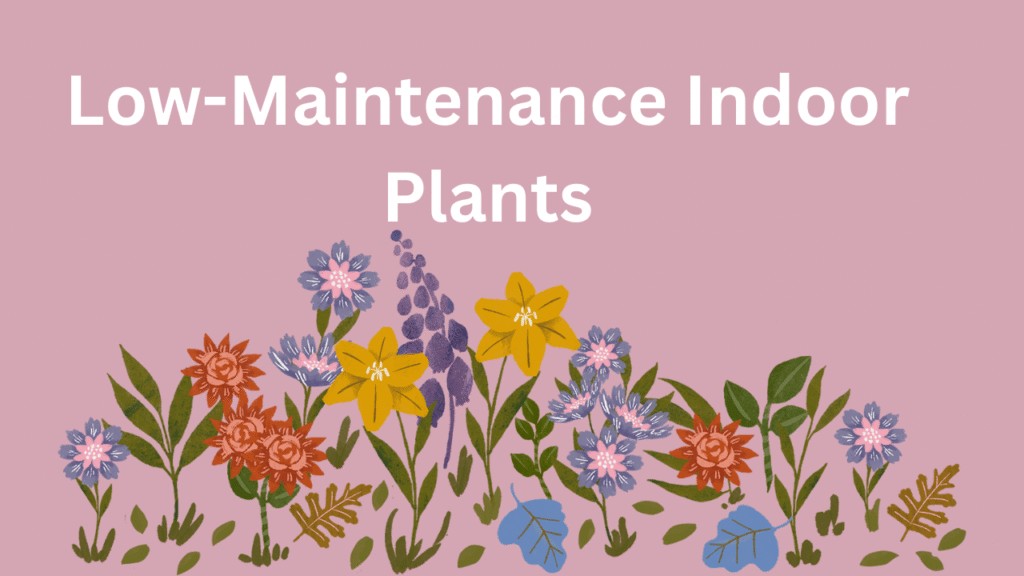Do you love the idea of having a lush, green home but worry that you don’t have the time—or the so-called green thumb—to keep plants alive? You’re not alone! Many people dream of bringing nature indoors but get discouraged because of busy schedules, lack of experience, or fear of killing their plants.
Here’s the good news: low-maintenance indoor plants exist, and they’re perfect for anyone—from beginners to seasoned gardeners who simply want easy-care greenery. These plants thrive with minimal effort, tolerate neglect, and still provide all the amazing benefits of indoor greenery: cleaner air, stress relief, and natural beauty.
Let’s dive in and discover how you can enjoy the beauty of houseplants without the stress of constant upkeep.
Why Choose Low-Maintenance Indoor Plants?
Not all plants are created equal when it comes to care. Some need daily attention, while others are so resilient they can handle weeks of neglect. If you’re a busy professional, a student, or simply someone new to plant care, low-maintenance plants are the best option.
Here’s why:
- Time-saving: They don’t need constant watering or special conditions.
- Forgiving: They can survive if you forget to water occasionally.
- Beginner-friendly: Perfect for people learning plant care.
- Stylish: Many low-maintenance plants are also statement pieces for home décor.
- Health benefits: Just like any other indoor plant, they clean air, reduce stress, and improve mood.
Best Low-Maintenance Indoor Plants
Here’s a list of tried-and-true low-maintenance houseplants that thrive with minimal effort.
1. Snake Plant (Sansevieria)
- Why it’s low-maintenance: Extremely tolerant of neglect.
- Care tips: Water every 2–3 weeks; thrives in low light.
- Benefits: Filters indoor air toxins and looks stylish in modern décor.
2. ZZ Plant (Zamioculcas zamiifolia)
- Why it’s low-maintenance: Can survive in dark corners and needs watering only once a month.
- Care tips: Place in low to bright, indirect light.
- Benefits: Glossy leaves make it a natural decorative piece.
3. Pothos (Devil’s Ivy)
- Why it’s low-maintenance: Adaptable and grows in almost any condition.
- Care tips: Water weekly and let soil dry in between. Works well in hanging baskets.
- Benefits: Easy to propagate; adds a trailing, jungle-like effect.
4. Spider Plant
- Why it’s low-maintenance: Resilient and grows “pups” (baby plants) for easy propagation.
- Care tips: Prefers indirect light; water once a week.
- Benefits: Non-toxic to pets and excellent for air purification.
5. Aloe Vera
- Why it’s low-maintenance: Succulent that thrives on neglect.
- Care tips: Needs bright, indirect light and very little water.
- Benefits: The gel inside leaves is useful for burns and skincare.
6. Rubber Plant (Ficus elastica)
- Why it’s low-maintenance: Can handle less frequent watering and adapts to different light conditions.
- Care tips: Water when soil feels dry; prefers indirect sunlight.
- Benefits: Large glossy leaves add bold greenery to any room.
7. Lucky Bamboo
- Why it’s low-maintenance: Grows in water or soil with minimal attention.
- Care tips: Change water every 2–3 weeks if grown in water.
- Benefits: Symbolizes luck and positive energy in Feng Shui.
8. Peace Lily
- Why it’s low-maintenance: Hardy, with beautiful blooms even in low light.
- Care tips: Keep soil slightly moist and place in shaded areas.
- Benefits: Natural air purifier and elegant decoration.
Step-by-Step Care Guide for Low-Maintenance Plants
Even though these plants don’t need much, a little care goes a long way. Follow this beginner-friendly routine:
Step 1: Pick the Right Spot
- Place low-light plants like snake plants and ZZ plants in darker corners.
- Sun-loving plants like aloe vera should be near windows.
Step 2: Water Smartly
- Most low-maintenance plants prefer to dry out before the next watering.
- Stick your finger 1 inch into the soil—if it’s dry, water lightly.
Step 3: Choose the Right Pot
- Always use pots with drainage holes.
- Avoid waterlogging, as it’s the main cause of plant death.
Step 4: Light & Temperature
- Keep plants away from direct, scorching sunlight.
- Maintain room temperature between 60–80°F (15–27°C).
Step 5: Occasional Feeding
- Use liquid fertilizer once a month during the growing season (spring/summer).
- Skip fertilizing in winter when plants grow slowly.
Step 6: Minimal Grooming
- Remove yellow or dead leaves to encourage fresh growth.
- Wipe leaves gently to remove dust.
Benefits of Low-Maintenance Indoor Plants
Bringing low-maintenance greenery into your home comes with both practical and lifestyle advantages:
- Cleaner air: Plants absorb toxins like benzene, formaldehyde, and carbon monoxide.
- Stress relief: Greenery creates a calming environment.
- Better focus: Ideal for work-from-home setups and study areas.
- Affordable hobby: They’re long-lasting and don’t require frequent replacements.
- Versatile décor: Perfect for any space—bedrooms, living rooms, or offices.
Common Mistakes to Avoid with Low-Maintenance Plants
Even the easiest plants can suffer if neglected incorrectly. Avoid these pitfalls:
- Overwatering – Most low-maintenance plants prefer drier soil.
- Wrong lighting – A shade-loving ZZ plant won’t thrive in direct sun.
- Ignoring pests – Occasionally check leaves for gnats or mites.
- No repotting – As plants grow, give them space with a bigger pot every 1–2 years.
- Using tap water – Some plants like lucky bamboo prefer filtered water.
Styling Tips for Low-Maintenance Plants
These plants don’t just survive—they thrive as home décor. Try these styling ideas:
- Snake plants in tall pots for empty corners.
- Pothos in hanging baskets for a cascading effect.
- Aloe vera on kitchen counters for beauty and practicality.
- Spider plants in groups to create a lush, tropical vibe.
- Rubber plants as statement pieces in living rooms.
Low-Maintenance Indoor Plants for Different Spaces
Bedroom
- Snake Plant (improves air at night)
- Peace Lily (promotes relaxation)
Living Room
- Rubber Plant (bold and stylish)
- Pothos (great for shelves or hanging baskets)
Kitchen
- Aloe Vera (useful for burns)
- Spider Plant (thrives in various light conditions)
Office Desk
- ZZ Plant (tolerates low light)
- Lucky Bamboo (symbol of prosperity)
Conclusion
You don’t need to be a gardening expert to enjoy the benefits of indoor plants. With low-maintenance indoor plants like snake plants, ZZ plants, pothos, and peace lilies, you can create a green, vibrant space with little effort. These plants are perfect for beginners, busy homeowners, or anyone looking to enjoy greenery without the stress of daily care.
🌿 Ready to bring effortless greenery into your life? Explore more plant care tips and inspiration at Green Plant Zone and start building your low-maintenance indoor jungle today.
FAQs About Low-Maintenance Indoor Plants
1. What is the easiest indoor plant to care for?
Snake plants and ZZ plants are the easiest—they survive with minimal light and water.
2. Which low-maintenance plants clean the air best?
Peace lilies, spider plants, and snake plants are excellent air purifiers.
3. Can low-maintenance indoor plants survive in low light?
Yes, ZZ plants, snake plants, and pothos thrive in low-light conditions.
4. How often should I water low-maintenance plants?
Most require watering every 1–2 weeks, depending on soil dryness.
5. Are low-maintenance plants good for offices?
Yes! ZZ plants, lucky bamboo, and snake plants are perfect for workspaces.

Hi, I’m the creator of Green Plant Zone, a space dedicated to plant lovers. I share tips on indoor and outdoor gardening, plant care guides, and eco-friendly living. My mission is to help you grow healthier, happier plants and bring more greenery into everyday life.
